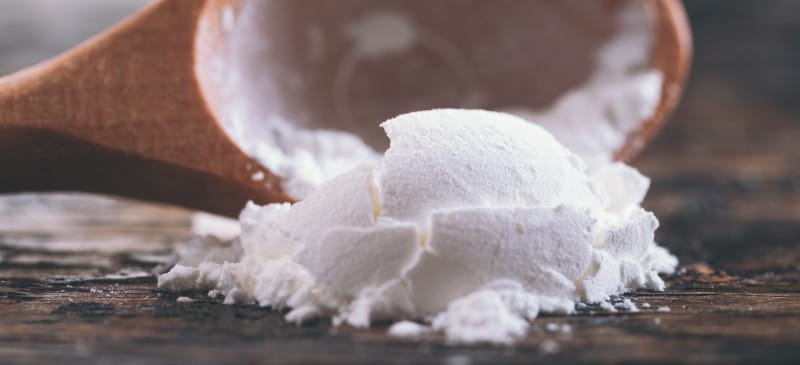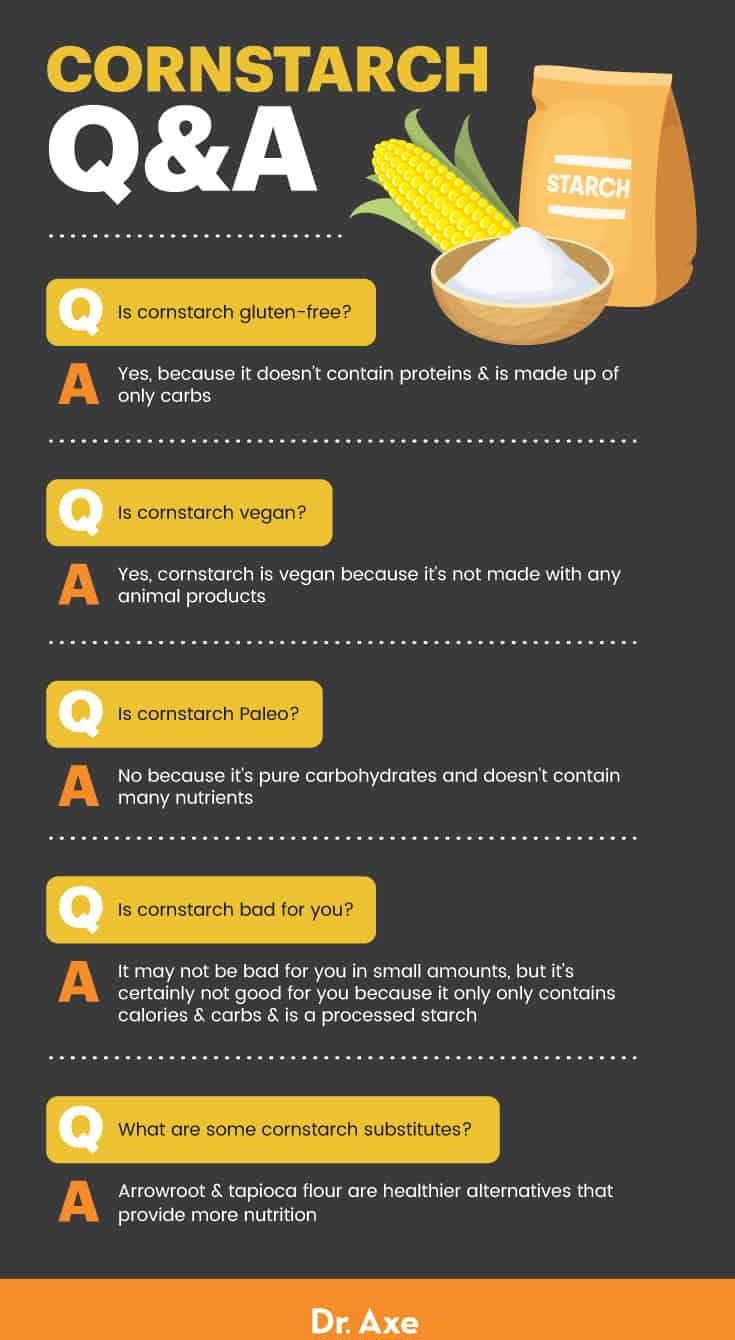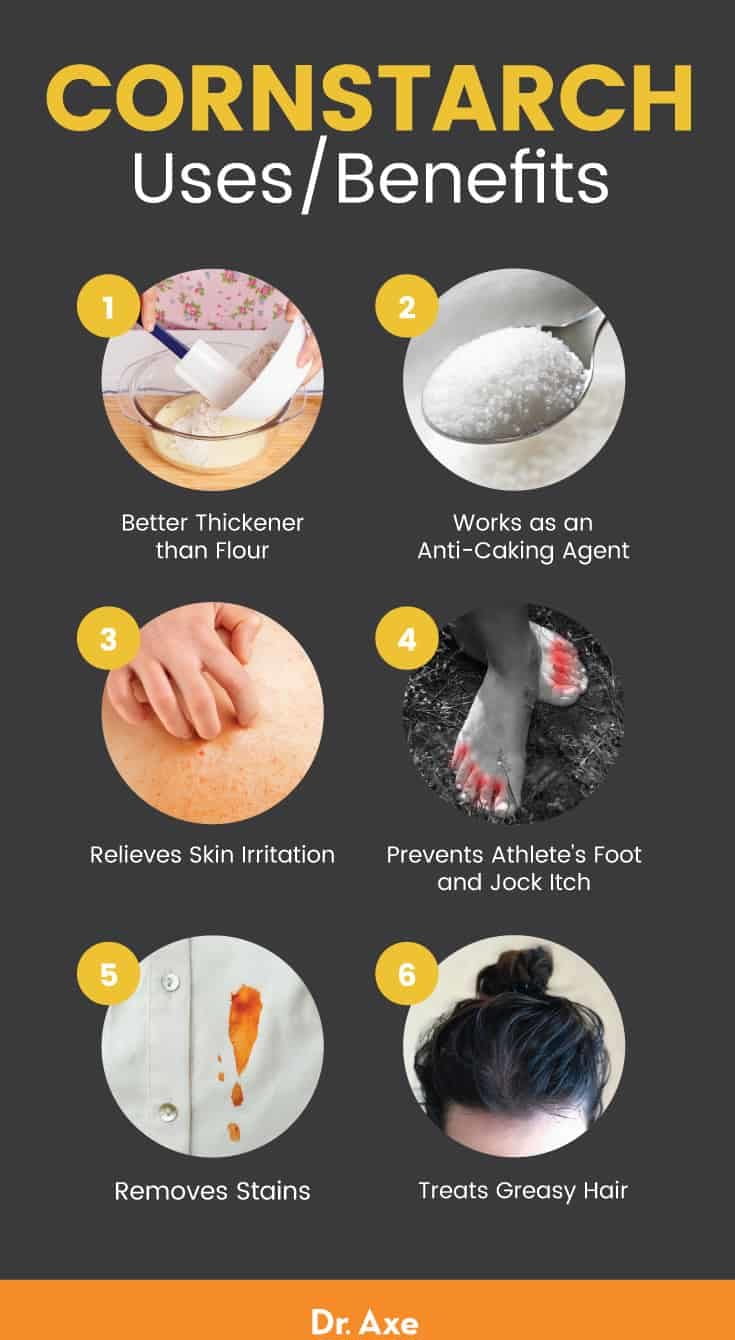Is Cornstarch a Healthy Ingredient?
Is Cornstarch Gluten-Free? Is cornstarch vegan? Is cornstarch Paleo?
Cornstarch

You’ve seen cornstarch on a food label before — in fact, it’s an ingredient that’s often added to soups, sauces and baked goods. But many people are confused about whether or not cornstarch can be considered a healthy food. We know that almost 90 percent of corn in the United States is genetically modified, so does that mean that products with cornstarch should be avoided? And you may be asking yourself “is cornstarch gluten-free?” If so, you’re not alone — but don’t worry, I have all of the answers you need about cornstarch right here — including the answer to the question is cornstarch gluten-free.
Cornstarch is indeed made from corn, and although the nutritional value of corn is worth noting, cornstarch doesn’t actually contain many nutrients at all. It’s a processed starch that’s commonly used as a thickener in cooking or even as a cleaning agent. I actually love using cornstarch around the house for removing stains and cleaning kitchen appliances, or even relieving skin irritations and getting rid of stinky feet, but when it comes to eating cornstarch, there are healthier, more natural alternatives out there. As to the question is cornstarch gluten-free, the answer may surprise you. So let’s take a look at this common thickener and get that answer to is cornstarch gluten-free.
Is Cornstarch Gluten-Free?
Cornstarch was invented in 1840 by a man named Thomas Kingsford. Kingsford was working in a Jersey City, N.J., wheat starch factory when he discovered this other use for the corn kernel. Originally, cornstarch was used to starch laundry and for other household tasks, but eventually it was used to make desserts, like custards, creams and puddings. Cornstarch is also used for household and industrial purposes.
Corn has three parts: the hull, which is the outer part; the germ, which is often used for animal feed or to make oil; and the endosperm, which contains protein and starch. To make cornstarch, the outside shells are removed from the corn kernels and the endosperms are ground into a gritty, white powder. This refining process requires specialized equipment that’s used to extract the starch from the kernel and remove the protein from the starch so it’s pure. (1)
People ask a lot of questions about cornstarch because it’s often an ingredient in packaged and processed foods, but few know how it’s made and processed. Here are some of the most common questions regarding cornstarch:
- Is cornstarch gluten-free? Because cornstarch doesn’t contain any proteins and it’s made up of only carbohydrates, it is considered a gluten-free grain. You can use cornstarch as a substitute for flour in many recipes. In fact, cornstarch is an even better thickener, and you only need half the amount when subbing cornstarch for flour. However, since it’s processed, I don’t recommend using cornstarch often.
- Is cornstarch vegan? Not only is cornstarch gluten-free, but yes, it’s vegan because it’s not made with any animal products. In fact, some people on a vegan diet use cornstarch and water as an egg substitute when cooking and baking. You can combine one tablespoon of non-GMO cornstarch with three tablespoons of warm water to get the same consistency as an egg.
- Is cornstarch Paleo? Cornstarch wouldn’t be considered Paleo-friendly because it’s pure carbohydrates and doesn’t contain many nutrients. Although cornstarch is usually present in small amounts when it’s used in recipes as a thickener, it’s highly processed, and unless you buy GMO-free products, it’s genetically modified too.
- Is cornstarch bad for you? Cornstarch is a processed starch, and it only contains calories and carbohydrates — no protein, sugars, fiber, vitamins or minerals. So the answer to this question is that it may not be bad for you in small amounts, but it’s certainly not good for you. Cornstarch also goes through an extraction process that usually involves very high temperatures and harsh chemicals, and unless you buy GMO-free cornstarch, it’s been modified in a way that doesn’t occur naturally.
- What are some cornstarch substitutes? If you typically use cornstarch as a thickening agent and you’re looking for a healthier alternative, try arrowroot instead. Unlike cornstarch, arrowroot contains fewer calories and carbohydrates, and it actually provides protein, vitamins and minerals — such as potassium, iron, magnesium, B vitamins and vitamin C. Plus, arrowroot is also gluten-free. Another cornstarch alternative is tapioca flour, which is also gluten-free and vegan-friendly. Tapioca flour can also be used as a binder or thickener for various kinds of foods and recipes. (2)

Related: Baby Powder Asbestos Dangers: Should You Worry?
Nutrition Facts
Now that we know the answer to the question is cornstarch gluten-free, let’s take a look at its nutrition. Cornstarch does come from the corn kernel, but it doesn’t have the same nutritional value as corn. This is because cornstarch is processed, and all that’s left is the starch. You’ll notice that it’s lacking in most nutrients.
A half cup (64 grams) of cornstarch contains about: (3)
- 244 calories
- 58 carbohydrates
- zero protein
- zero sugar
- zero fiber
- 0.3 milligrams iron (2 percent DV)
- 8 milligrams phosphorus (1 percent DV)
- 1 milligram calcium (less than 1 percent DV)
- 2 milligrams magnesium (less than 1 percent DV)
- 2 milligrams potassium (less than 1 percent DV)
- 6 milligrams sodium (less than 1 percent DV)
- 0.04 milligrams zinc (less than 1 percent DV)
Benefits of Cornstarch
1. A Better Thickener than Flour
Cornstarch is used in baking to thicken sauces, gravies, yogurts, pies, tarts and other desserts so they don’t turn out too watery or runny. Wondering how this works? Cornstarch is made up of long chains of starch molecules. When it’s heated in water, it undergoes a transition process and the molecules are broken down. They then unravel and swell, which is called gelatinization, and this causes it to thicken. (4)
Chefs and bakers often prefer to use cornstarch as a thickener over flour because it’s relatively flavorless, creates a transparent gel, unlike flour that has more of an opaque color, and it has nearly double the thickening power. Compared to using flour, it takes half the volume of cornstarch to work as a thickening agent. Plus, cornstarch is gluten-free, so it can be used to add fullness and moisture to your favorite gluten-free baked goods.
2. Works as an Anti-Caking Agent
Cornstarch effectively absorbs moisture, so it can be used as an anti-caking agent. That means that it’s added in small amounts to dry foods so they remain dry and don’t cake or lump together. Cornstarch coats foods and particles, making them more water-repellant. That’s why cornstarch is sometimes added to dry, packaged foods.
Because of its anti-caking effects, cornstarch can also be added to your cosmetics, like lipstick, foundation and bronzer, to reduce the shine that’s caused by sweat and moisture. Adding cornstarch will give you a matte look that’s tough to hold up throughout a long day.
3. Relieves Skin Irritation
Creating a paste with cornstarch and applying it to skin irritations can be soothing and relieve irritation. You can use cornstarch on bug bites, chaffed areas, diaper rash, sunburns and skin infections to reduce itching and pain. Add two to three tablespoons of cornstarch to cool water, and mix it until it forms a thick paste. Then apply the mixture to the area of concern, and rinse it away once it dries. (5)
To help relieve sunburn, add one cup of cornstarch to warm bath water and soak for 20 to 30 minutes. You can also dip gauze pads in a combination of cornstarch and water and let them rest on your sunburn for 30 minutes.
4. Prevents Athlete’s Foot and Jock Itch
Athlete’s foot and jock itch are caused by sweat buildup in your shoes or groin area. This leads to the formation of several types of mold — like fungi, called dermatophytes. When your feet or groin become warm and moist areas, these fungi have the perfect environment to live and grow. Thankfully, cornstarch can be used to get rid of jock itch and athlete’s foot for good. That’s because cornstarch absorbs moisture and keeps you dry.
If you already have athlete’s foot or jock itch, cornstarch can be used as a natural remedy because it helps keep your skin fresh and dry, while soothing the burning, itchy and raw effects of these issues. Simply apply cornstarch to the area of concern once it’s clean and dry, just like you would baby powder. To take it one step further, combine one to two drops of tea tree oil with cornstarch and warm water to create an antifungal rub. (6)
5. Removes Stains
Because cornstarch absorbs moisture, it can be used to remove oil, food or even blood stains from your clothing or furniture. Simply create a paste with cornstarch and water, apply it to the stained area, and rub it in. You’ll notice it working immediately. Let it sit on the stain for a bit, and then wash it away.
You can also use cornstarch as a natural cleaning product. It can effectively clean tough grease or spots off of your pots and pans, silverware, and kitchen appliances. Just use the cornstarch paste and a coarse sponge.
6. Treats Greasy Hair
You can use cornstarch to make your own dry shampoo and get rid of greasy hair. It works by soaking up excess oil that makes your hair greasy, so instead of shampooing your hair every day, you can use a mix of cornstarch, lavender oil and peppermint oil to give longer life to your hairstyles or just to freshen up. Cornstarch works best for people with light hair, so if you have dark hair, try using cinnamon or cocoa powder instead.

How to Use
If you’re planning to cook with cornstarch, make sure to purchase an organic, GMO-free product. You can find GMO-free cornstarch at your local health food store.
To use cornstarch as a thickening agent, first add it to liquid that’s at room temperature, stir it and then add hot water. If you add cornstarch directly to hot water without letting it thicken first, it may become lumpy. To use cornstarch as an egg substitute in recipes, just add one tablespoon of cornstarch to three tablespoons of water.
You can also use cornstarch to keep dry ingredients from becoming moist. This can be helpful with dry soup packets, cake mix or grains that you store in your kitchen.
To store cornstarch, make sure it’s kept in a sealed container in a cool and dry place. You don’t want it to be able to absorb moisture or be exposed to extreme heat.
Cornstarch is best used for DIY recipes — here are some of my favorites:
Risks and Side Effects
Have you ever heard of pica? It’s a compulsive eating behavior that involves people craving unnatural and non-nutritive substances like starch, baking soda, clay, chalk and even dirt. This condition has been observed in both men and women of all ages and ethnicities, and it can cause significant health risks. Research shows that patients with pica are susceptible to electrolyte and metabolic disorders, tooth wear, lead and mercury poisoning, intestinal obstruction, and gastrointestinal problems. Scientists also believe that pica is associated with iron deficiency anemia. (7)
If you notice cravings for foods like cornstarch or other substances that are not food and don’t provide nutritional value, talk to your health care provider. You may want to be tested for vitamin and mineral deficiencies or speak to a counselor about your eating disorder. (8)
Final Thoughts
- Cornstarch is a carbohydrate that’s extracted from the endosperm of corn, which is found at the heart of the kernel. It’s a white, powdery substance that serves as a thickener or binder, which is why it’s commonly used in cooking.
- Is cornstarch gluten-free? Yes. It’s also vegan- and vegetarian-friendly, but make sure to purchase only GMO-free cornstarch in your local health food store.
- Cornstarch may not be bad for you in small amounts, but it doesn’t contain any nutrients while being relatively high in calories and carbohydrates. For that reason, I prefer to use arrowroot as a thickener in my recipes.
- When I do use cornstarch, it’s for household purposes and DIY recipes. Cornstarch is great for removing stains, relieving irritated skin, cleaning grease, and absorbing moisture from your hair, socks, sneakers and sports equipment.





Leave a comment